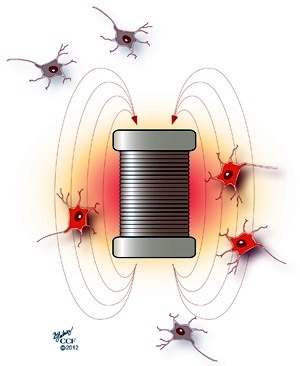
Image Credit: Cleveland Clinic Center for Medical Art and Photography
After attending NANS2025 I posted about work being done by various universities and at least one startup company on “micromagnetic stimulation” (μMS).
However, yesterday I received an e-mail from Dr. Bradley Roth from Oakland University. He shared with me two interesting papers in which he and his PhD student Mohammed Alzahrani calculated that the electric field induced by microcoils in the brain would be too small to excite neurons, and thus posits that stimulation in experimental studies may be the result of capacitive coupling.
From Alzahrani M, Roth BJ. The Electric Field Induced by a Microcoil During Magnetic Stimulation. IEEE Trans Biomed Eng. 2023 Nov;70(11):3260-3262 :
“Abstract
Objective: The purpose of this study is to calculate the electric field produced by an implanted microcoil during magnetic stimulation of the brain.
Methods: The electric field of a microcoil was calculated numerically.
Results: The maximum value of the induced electric field is approximately 0.000026 V/m for a 1 mA, 3 kHz current passed through the coil.
Conclusion: This electric field value is too small to cause neural stimulation.
Significance: Previous studies reporting magnetic stimulation using a microcoil must have been exciting neurons by some other mechanism.”
The other paper which describes the core of Mohammed Alzahrani’s dissertation is: The Calculation of Maximum Electric Field Intensity in Brain Tissue Stimulated by a Current Pulse through a Microcoil via Capacitive Coupling, which is available as an open access article.
As I mentioned in my original post:
“Many years ago I built a magnetic nerve stimulator that dumped a large bank of capacitors (2,100 μF) charged to 1,350V into a coil of very hefty litz wire. rTMS devices, which stimulate the brain with similar magnetic pulses at a frequency of around 10Hz require water-cooled coils.
Based on this experience, I wouldn’t have thought that magnetic stimulation could be scaled into something that could be implanted. “
My gut feeling may have been right after all…
Thank you Brad for bringing your work to my attention! I’ll keep my eyes open and report about developments in this field.

